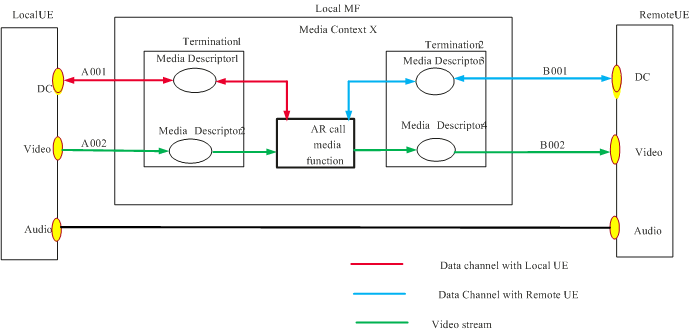Content for TS 24.186 Word version: 19.0.0
C Applications based on IMS data channel
C.1 General
C.2 AR communication
C.2.1 AR Remote Cooperation
C.2.2 Procedures
C.2.2.1 Data Channel Setup
C.2.2.2 Closing Data Channel
$ Change history
C (Normative) Applications based on IMS data channel p. 53
C.1 General p. 53
The present annex depicts the applications based on the IMS data channel, including the corresponding procedures.
C.2 AR communication p. 53
C.2.1 AR Remote Cooperation p. 53
C.2.1.1 General Description p. 53
According to clause 6.39.2 of TS 22.261, the IMS network should support AR media processing. AR Remote Cooperation is a typical AR call service and the detailed user experience of AR Remote Cooperation is described in clause 5.3 of TR 22.873.
It's assumed that the local UE shares the camera to the remote UE for assistance, and the remote UE displays the shared camera and provides assistances. A voice call is established between local UE and remote UE, and then AR Remote Assistance application is triggered by local UE.
The overall solution is based on IMS DC architecture specified in Annex AC of TS 23.228 and shown as follows:
- The local UE triggers the media renegotiation for AR Remote Cooperation based on user actions to establish a new video stream to transmit local video content (see A002 in Figure C.2.1.1-1) and an application data channel to transmit AR anchors (see A001 in Figure C.2.1.1-1).
- After the DCSF recognizes the AR Remote Cooperation service, it anchors the video stream and application data channel to MF. Then the DCSF initiates media renegotiation with remote UE to establish a new video stream to transmit local video content (see B002 in Figure C.2.1.1-1) and an application data channel to transmit AR anchors (see B001 in Figure C.2.1.1-1).
- The local UE may decide to start AR media split rendering negotiation as specified in TS 26.264 and TS 23.228.
- The local UE or remote UE extract the original AR anchors input from the user and transmits the anchors to the MF through the application data channel.
- The local UE and remote UE receives the updated AR anchors from the MF, displays it on the video stream.

Table C.2.1.1-1 lists the media streams for the AR Remote Cooperation.
| Media ID (Example) | Media Resource Type | Direction | Description |
|---|---|---|---|
| A001 | DC | bi-directional | Transmit upstream and downstream AR anchors between MF and local UE and the split rendering messages. |
| A002 | Video | unidirectional | Transmit video content from local UE to the MF. |
| B001 | DC | bi-directional | Transmit upstream and downstream AR anchors between the MF and remote UE. |
| B002 | Video | unidirectional | Transmit local UE's video content to remote UE. |
C.2.2 Procedures p. 54
C.2.2.1 Data Channel Setup p. 54
C.2.2.1.1 Procedure at the UE p. 54
Once AR remote cooperation application is launched, the local UE sends a SIP re-INVITE request with an SDP offer which includes a video media description with an "a=sendonly" attribute line to establish a video stream (see B001 in Figure C.2.1.1-1) as specified in TS 24.229 and TS 24.173 and a data channel media description with "a=dcmap" attribute line containing "stream-id" parameter set to the values starting at 1000 and "a=3gpp-req-app" attribute line to establish an application data channel (see A001 in Figure C.2.1.1-1) as specified in clause 9.3. The "a=3gpp-req-app" attribute line indicates that the newly established application data channel is used for AR Remote Cooperation application.
After application data channel and video stream established, the local UE may decide to start split rendering. If the local UE decides to split rendering, the UE shall use the procedure defined in TS 26.264.
After split rendering negotiation procedure finished, both the local UE or remote UE extracts the original AR anchors input by the user and transmits it to MF through the established application data channel.
When receiving the updated AR anchors transmitted via application data channel from the MF, both the local UE and the remote UE displays the updated AR anchors based on video stream.
C.2.2.1.2 Procedure at the IMS AS p. 55
When receiving the SIP re-INVITE request from local UE, IMS AS shall notify the DCSF about media change request related to local UE requesting to setup an application data channel and a new video.
When receiving media reservation instruction from DCSF, the IMS AS shall convert the media instructions to the corresponding media resource operations and request MF to create or update media resources, and reserve media processing resources for AR Remote Cooperation.
When receiving response from MF on the media resources reservation or update, IMS AS sends media reservation response to DCSF, indicating the URL addresses of each stream involved AR Remote Cooperation service control, which is specified in 3GPP TS 29.175 [18].
C.2.2.2 Closing Data Channel p. 55
If the UE wants to close the AR remote cooperation related application data channels, the procedure defined in clause 9.3 applies.